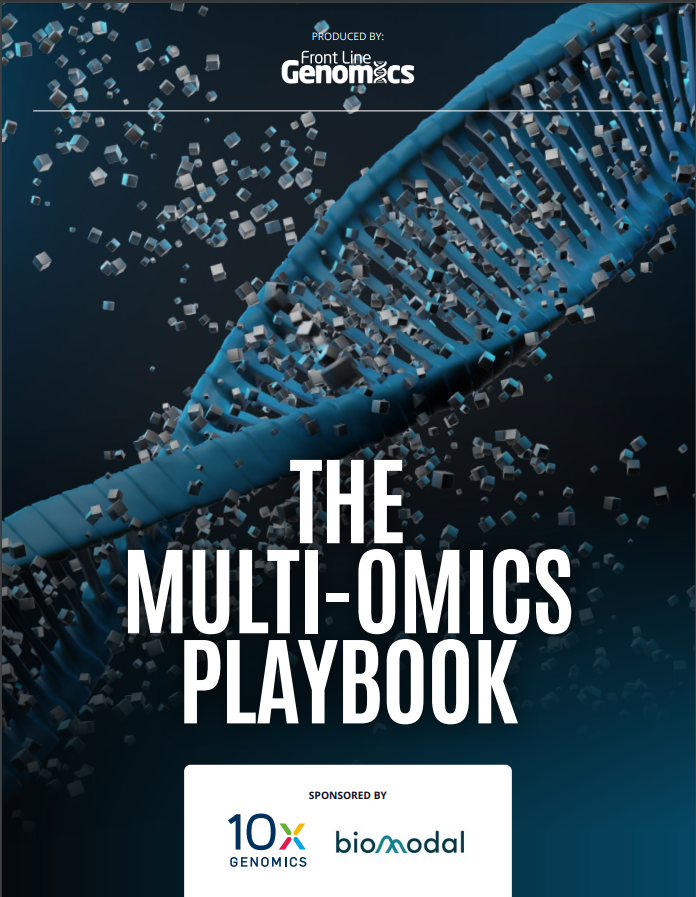
The Multi-Omics Playbook
Multi-omics is fast becoming the new standard for biomarker identification and molecular biology in general. Why look at just the transcriptome or the genome when you can also look at the proteome, the epigenome or even the metabolome?
The Multi-omics Playbook is the 2nd edition of our annual free-to-download multi-omics intelligence report and is chocked full of valuable intel. Within you will find overviews of the latest multi-omics technologies, an in-depth guide on how to integrate multi-omics data and plenty of use-cases from the last 18 months highlighting the pinnacle of multi-omics experimentation to date.
What’s included in the report?
- Contributions from experts across various multi-omics fields
- An overview of vertical, horizontal and diagonal integration methods
- Details on the latest commercial technology developments
- The latest methods and techniques for RNA/Protein and RNA/Epigenomics experiments
- Spotlights on AI and machine learning methods for multi-omics data
- Coverage of the up-and-coming field - single-cell and spatial metabolomics
- Applications of multi-omics in the clinic and in drug discovery
- Expert views and practical advice
Hear from 20 Expert Contributors:
- Nima Aghaeepour, Associate Professor, Anaesthesiology, Perioperative and Pain Medicine & Paediatrics - Neonatal and Developmental Medicine, Stanford University
- Theodore Alexandrov, Team Leader, Structural and Computational Biology Unit, European Molecular Biology Laboratory (EMBL)
- Ricard Argelaguet, Senior Research Scientist, Altos Labs
- Mathew Chamberlain, Principal Scientist, Johnson & Johnson Innovative Medicine
- Rui Chen, Professor of Molecular and Human Genetics, Baylor College of Medicine
- Andrea Corsinotti, Single-cell Multi-omics Facility Manager, Centre for Regenerative Medicine, Institute for Regeneration and Repair, University of Edinburgh
- Mirjana Efremova, Group Leader, Barts Cancer Institute
- Shirley Greenbaum, Postdoctoral fellow, Department of Pathology, Stanford University, &
- Resident, Department of Obstetrics and Gynaecology, Hadassah-Hebrew University Medical Center
- Holly-May Lewis, Senior Laboratory Technician (LC-MS), University of Surrey
- Ingela Lanekoff, Professor, Department of Chemistry-BMC, Uppsala University
- Qin Ma, Professor, Department of Biomedical Informatics, The Ohio State University
- Zongming Ma, Professor, Department of Statistics and Data Science, Yale University
- Iain Macaulay, Technical Development Group Leader, Earlham Institute
- Pau Badia i Mompel, PhD Candidate, Saez-Rodriguez Group, Heidelberg University
- Samantha Morris, Associate Professor of Development Biology and Genetics, Washington University School of Medicine in St. Louis
- Sushmita Roy, Professor, Department of Biostatistics and Medical Informatics, University of Wisconsin-Madison, & Faculty, Wisconsin Institute of Discovery
- Xiaotao Shen, Postdoctoral Research Fellow, Snyder Lab, Stanford University
- Suhas Vasaikar, Principal Scientist, Clinical Biomarker and Diagnostics, Seattle Genetics (Seagen)
- Judith Zaugg, Group Leader, European Molecular Biology Laboratory (EMBL)
- Bingjie Zhang, Postdoctoral Research Fellow, Satija Lab, New York Genome Center
Contents:
Chapter 1: Into the Multi-omics-verse
This chapter presents a general introduction to multi-omics, what is it, why perform it. We briefly introduce single-cell and spatial multi-omics before briefly addressing each ‘omic’ in turn, and discuss the inherent value of looking at omics together in the same experiment. What can we learn about the secret life of cells from the pursuit of multimodal data?
Chapter 2: Bringing Omics Together. Integrating multi-omics data
One of the principal challenges in multi-omics is integrating data from different omics. In this chapter, we will look at different computational tools and services to integrate multiomics data from different datasets and from within the same experiment.
Chapter 3: Meet the Machinery. The latest multi-omics technologies
The multi-omics revolution has been led by technology developers. This chapter will give an update on the latest available technologies, highlighting both the ‘in-house’ and the commercial offerings, with a particular focus on the latest spatial multi-omics instruments.
Chapter 4: Deconvoluting Dogma. DNA, RNA and Protein multi-omics
This chapter will overview methods to sequence the genome, transcriptome and/or proteome concurrently. Special attention will be paid to the emerging technologies for single-cell and spatial transcriptomics and proteomics.
Chapter 5: Getting to Grips with Gene Regulation. DNA/RNA and Epigenetic multi-omics
By looking at genomic, transcriptomic and, importantly, epigenomic data, we can begin to see how gene regulation is co-ordinated. This chapter will summarise multi-omics methods for DNA, RNA and the epigenome, as well as the burgeoning interest in mapping gene regulatory networks (GRNs).
Chapter 6: Back to Building Blocks: The rise of metabolomics
Once a gene is translated into a protein, that’s the end of the story, right? Wrong. This chapter introduces and covers the major methods used to capture the small molecular molecules often ignoring in genomics - the metabolome. Sugars, lipids, nucleotides and amino acids can all be measured and provide interesting data to understand complex phenotypes.
Chapter 7: Malleable Multi-omics. The various applications of multi-modal data
Multi-modal data helps us get a clearer understanding of the molecular processes in cells. This is turn makes it extremely useful for scientists. In this chapter we will review the applications of multi-omics in both the clinic and in drug discovery, and how AI and data analytics are used to improve outcomes.
Chapter 8: Insights from the Multi-omics-Verse
In this final chapter, we wanted to explore the remaining hurdles facing multi-omics projects. So, we asked all of our contributors the same question - What are the greatest challenges facing their field and is there anything we can do to address them?
Download Report
ABOUT US CONTACT ADVERTISE PRIVACY POLICY
Front Line Genomics Limited is registered in England and Wales. Company Number 10421716, VAT: GB 297 742 548.
Registered Office: Ground Floor, Cromwell House, 15 Andover Road, Winchester, Hampshire, SO23 7BT
